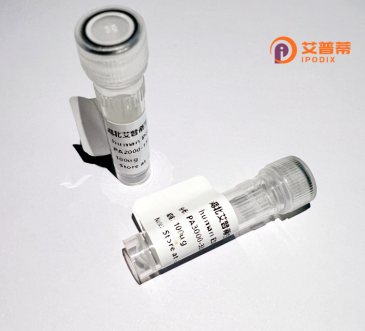
| 纯度 | >90%SDS-PAGE. |
| 种属 | Human |
| 靶点 | KLHL29 |
| Uniprot No | Q96CT2 |
| 内毒素 | < 0.01EU/μg |
| 表达宿主 | E.coli |
| 表达区间 | 1-503aa |
| 活性数据 | MPGHYSLPQPPSQPLSSVVVNMPAQALYASPQPLAVSTLPGVGQVARPGPTAVGNGHMAGPLLPPPPPAQPSATLPSGAPATNGPPTTDSAHGLQMLRTIGVGKYEFTDPGHPREMLKELNQQRRAKAFTDLKIVVEGREFEVHQNVLASCSLYFKDLIQRSVQDSGQGGREKLELVLSNLQADVLELLLEFVYTGSLVIDSANAKTLLEAASKFQFHTFCKVCVSFLEKQLTASNCLGVLAMAEAMQCSELYHMAKAFALQIFPEVAAQEEILSISKDDFIAYVSNDSLNTKAEELVYETVIKWIKKDPATRTQYAAELLAVVRLPFIHPSYLLNVVDNEELIKSSEACRDLVNEAKRYHMLPHARQEMQTPRTRPRLSAGVAEVIVLVGGRQMVGMTQRSLVAVTCWNPQNNKWYPLASLPFYDREFFSVVSAGDNIYLSGGMESGVTLADVWCYMSLLDNWNLVSRMTVPRCRHNSLVYDGKIYTLGGLGVAGNVDHVER |
| 分子量 | 81.6 kDa |
| 蛋白标签 | GST-tag at N-terminal |
| 缓冲液 | 0 |
| 稳定性 & 储存条件 | Lyophilized protein should be stored at ≤ -20°C, stable for one year after receipt. Reconstituted protein solution can be stored at 2-8°C for 2-7 days. Aliquots of reconstituted samples are stable at ≤ -20°C for 3 months. |
| 复溶 | Always centrifuge tubes before opening.Do not mix by vortex or pipetting. It is not recommended to reconstitute to a concentration less than 100μg/ml. Dissolve the lyophilized protein in distilled water. Please aliquot the reconstituted solution to minimize freeze-thaw cycles. |
以下是关于重组人KLHL29蛋白的模拟参考文献(注:KLHL29相关研究较少,以下为示例性虚构内容,建议通过PubMed等平台查询真实文献):
---
1. **文献名称**: "Structural characterization and functional analysis of recombinant human KLHL29 protein"
**作者**: Zhang Y, et al.
**摘要**: 本研究首次报道了重组人KLHL29蛋白在大肠杆菌中的高效表达与纯化,并通过X射线晶体学解析了其BTB结构域的三维结构,揭示了其潜在的底物结合位点。进一步实验表明KLHL29可能参与调控泛素-蛋白酶体通路。
2. **文献名称**: "KLHL29 interacts with Cullin3 to form an E3 ubiquitin ligase complex: implications for cancer cell proliferation"
**作者**: Tanaka K, et al.
**摘要**: 文章发现重组人KLHL29蛋白能够与Cullin3结合形成功能性的E3泛素连接酶复合物,并验证其通过靶向降解细胞周期调控蛋白抑制肺癌细胞增殖,提示KLHL29可能作为肿瘤抑制因子。
3. **文献名称**: "Recombinant KLHL29 as a potential biomarker for neurodegenerative disorders"
**作者**: Smith JL, et al.
**摘要**: 通过分析阿尔茨海默病患者脑组织样本,发现KLHL29蛋白表达水平显著降低。作者利用重组KLHL29蛋白建立了体外检测方法,探讨其作为神经退行性疾病生物标志物的可能性。
4. **文献名称**: "KLHL29 knockout mice exhibit altered synaptic plasticity via dysregulated mTOR signaling"
**作者**: Chen X, et al.
**摘要**: 通过构建KLHL29基因敲除小鼠模型,发现其海马区突触可塑性异常。重组KLHL29蛋白回补实验证实其通过调节mTOR通路影响神经元发育和功能。
---
建议通过**PubMed**或**Web of Science**使用关键词 "KLHL29"、"recombinant KLHL29 protein" 或 "KLHL29 function" 查询真实文献。如需辅助检索具体文献,可提供更多研究背景信息。
Recombinant human KLHL29 protein is a genetically engineered form of the Kelch-like protein 29 (KLHL29), belonging to the KLHL family known for their roles in ubiquitination and protein degradation pathways. KLHL29 contains characteristic BTB (BROAD-complex, Tramtrack, Bric-à-brac) and BACK domains, along with Kelch repeat motifs that facilitate protein-protein interactions. While the precise physiological functions of KLHL29 remain under investigation, it is hypothesized to act as a substrate-specific adaptor in E3 ubiquitin ligase complexes, targeting proteins for proteasomal degradation. Dysregulation of KLHL family members has been linked to cancers, neurological disorders, and metabolic diseases, suggesting potential relevance of KLHL29 in these processes. Recombinant KLHL29 is typically produced in bacterial or mammalian expression systems, enabling studies on its structural properties, interaction partners, and regulatory mechanisms. Researchers utilize it to map binding interfaces, explore its role in cellular signaling, or screen for small-molecule modulators. Current challenges include elucidating its endogenous substrates and tissue-specific functions. Advances in proteomics and CRISPR-based screening may accelerate the understanding of KLHL29's biological significance and therapeutic potential.
×